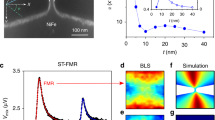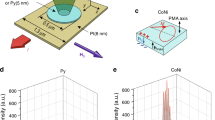Abstract
With the advent of pure-spin-current sources, spin-based electronic (spintronic) devices no longer require electrical charge transfer, opening new possibilities for both conducting and insulating spintronic systems1,2,3,4,5,6,7,8,9. Pure spin currents have been used to suppress noise caused by thermal fluctuations in magnetic nanodevices, amplify propagating magnetization waves, and to reduce the dynamic damping in magnetic films10,11,12,13,14. However, generation of coherent auto-oscillations by pure spin currents has not been achieved so far. Here we demonstrate the generation of single-mode coherent auto-oscillations in a device that combines local injection of a pure spin current with enhanced spin-wave radiation losses. Counterintuitively, radiation losses enable excitation of auto-oscillation, suppressing the nonlinear processes that prevent auto-oscillation by redistributing the energy between different modes12,15. Our devices exhibit auto-oscillations at moderate current densities, at a microwave frequency tunable over a wide range. These findings suggest a new route for the implementation of nanoscale microwave sources for next-generation integrated electronics.
This is a preview of subscription content, access via your institution
Access options
Subscribe to this journal
Receive 12 print issues and online access
$259.00 per year
only $21.58 per issue
Buy this article
- Purchase on Springer Link
- Instant access to full article PDF
Prices may be subject to local taxes which are calculated during checkout




Similar content being viewed by others
References
Maekawa, S. Concepts in Spin Electronics (Oxford Univ. Press, 2006).
Johnson, M. & Silsbee, R. H. Interfacial charge-spin coupling: Injection and detection of spin magnetization in metals. Phys. Rev. Lett. 55, 1790–1793 (1985).
Jedema, F. J., Filip, A. T. & van Wees, B. J. Electrical spin injection and accumulation at room temperature in an all-metal mesoscopic spin valve. Nature 410, 345–348 (2001).
Lou, X. et al. Electrical detection of spin transport in lateral ferromagnet–semiconductor devices. Nature Phys. 3, 197–202 (2007).
Yang, T., Kimura, T. & Otani, Y. Giant spin-accumulation signal and pure spin-current-induced reversible magnetization switching. Nature Phys. 4, 851–854 (2008).
Slachter, A., Bakker, F. L., Adam, J-P. & van Wees, B. J. Thermally driven spin injection from a ferromagnet into a non-magnetic metal. Nature Phys. 6, 879–882 (2010).
Saitoh, E., Ueda, M., Miyajima, H. & Tatara, G. Conversion of spin current into charge current at room temperature: Inverse spin-Hall effect. Appl. Phys. Lett. 88, 182509 (2006).
Kajiwara, Y. et al. Transmission of electrical signals by spin-wave interconversion in a magnetic insulator. Nature 464, 262–266 (2010).
Kurebayashi, H. et al. Controlled enhancement of spin-current emission by three-magnon splitting. Nature Mater. 10, 660–664 (2011).
Ando, K. et al. Electric manipulation of spin relaxation using the spin Hall effect. Phys. Rev. Lett. 101, 036601 (2008).
Liu, L. et al. Spin-torque ferromagnetic resonance induced by the spin Hall effect. Phys. Rev. Lett. 106, 036601 (2011).
Demidov, V. E. et al. Control of magnetic fluctuations by spin current. Phys. Rev. Lett. 107, 107204 (2011).
Wang, Z., Sun, Y., Wu, M., Tiberkevich, V. & Slavin, A. Control of spin waves in a thin film ferromagnetic insulator through interfacial spin scattering. Phys. Rev. Lett. 107, 146602 (2011).
Demidov, V. E., Urazhdin, S., Edwards, E. R. J. & Demokritov, S. O. Wide-range control of ferromagnetic resonance by spin Hall effect. Appl. Phys. Lett. 99, 172501 (2011).
Suhl, H. The theory of ferromagnetic resonance at high signal powers. J. Phys. Chem. Solids 1, 209–227 (1957).
Demidov, V. E. et al. Nano-optics with spin waves at microwave frequencies. Appl. Phys. Lett. 92, 232503 (2008).
Kruglyak, V. V., Demokritov, S. O. & Grundler, D. Magnonics. J. Phys. D 43, 264001 (2010).
Lenk, B., Ulrichs, H., Garbs, F. & Münzenberg, M. The building blocks of magnonics. Phys. Rep. 507, 107–136 (2011).
Tsoi, M. et al. Excitation of a magnetic multilayer by an electric current. Phys. Rev. Lett. 80, 4281–4284 (1998).
Kiselev, S. I. et al. Microwave oscillations of a nanomagnet driven by a spin-polarized current. Nature 425, 380–383 (2003).
Kaka, S. et al. Mutual phase-locking of microwave spin torque nano-oscillators. Nature 437, 389–392 (2005).
Mancoff, F. B., Rizzo, N. D., Engel, B. N. & Tehrani, S. Phase-locking in double-point-contact spin-transfer devices. Nature 437, 393–395 (2005).
Slavin, A. & Tiberkevich, V. Spin wave mode excited by spin-polarized current in a magnetic nanocontact is a standing self-localized wave bullet. Phys. Rev. Lett. 95, 237201 (2005).
Dyakonov, M. I. & Perel, V. I. Possibility of orienting electron spins with current. JETP Lett. 13, 467–469 (1971).
Hirsch, J. E. Spin Hall effect. Phys. Rev. Lett. 83, 1834–1837 (1999).
Mosendz, O. et al. Quantifying spin Hall angles from spin pumping: Experiments and theory. Phys. Rev. Lett. 104, 046601 (2010).
Chernyshov, A. et al. Evidence for reversible control of magnetization in a ferromagnetic material by means of spin–orbit magnetic field. Nature Phys. 5, 656–659 (2009).
Miron, I. M. et al. Current-driven spin torque induced by the Rashba effect in a ferromagnetic metal layer. Nature Mater. 9, 230–234 (2010).
Demokritov, S. O. & Demidov, V. E. Micro-Brillouin light scattering spectroscopy of magnetic nanostructures. IEEE Trans. Mag. 44, 6–12 (2008).
Slonczewski, J. C. Excitation of spin waves by an electric current. J. Magn. Magn. Mater. 195, L261–L268 (1999).
Acknowledgements
We acknowledge support from Deutsche Forschungsgemeinschaft, National Science Foundation of the USA, and the DARPA of the USA. We thank R. Schlesiger for the assistance in sample imaging.
Author information
Authors and Affiliations
Contributions
V.E.D. and H.U. performed measurements and data analysis. S.U. designed and fabricated the samples and performed data analysis. V.T. and A.S. developed the theory. D.B. and G.S. performed the sample characterization. S.O.D. formulated the experimental approach and managed the project. All authors co-wrote the manuscript.
Corresponding author
Ethics declarations
Competing interests
The authors declare no competing financial interests.
Supplementary information
Supplementary Information
Supplementary Information (PDF 449 kb)
Rights and permissions
About this article
Cite this article
Demidov, V., Urazhdin, S., Ulrichs, H. et al. Magnetic nano-oscillator driven by pure spin current. Nature Mater 11, 1028–1031 (2012). https://doi.org/10.1038/nmat3459
Received:
Accepted:
Published:
Issue Date:
DOI: https://doi.org/10.1038/nmat3459
This article is cited by
-
Easy-plane spin Hall oscillator
Communications Physics (2023)
-
Classification tasks using input driven nonlinear magnetization dynamics in spin Hall oscillator
Scientific Reports (2023)
-
Impact of inherent energy barrier on spin-orbit torques in magnetic-metal/semimetal heterojunctions
Nature Communications (2023)
-
Coherent magnon-induced domain-wall motion in a magnetic insulator channel
Nature Nanotechnology (2023)
-
Hybrid spin Hall nano-oscillators based on ferromagnetic metal/ferrimagnetic insulator heterostructures
Nature Communications (2023)



